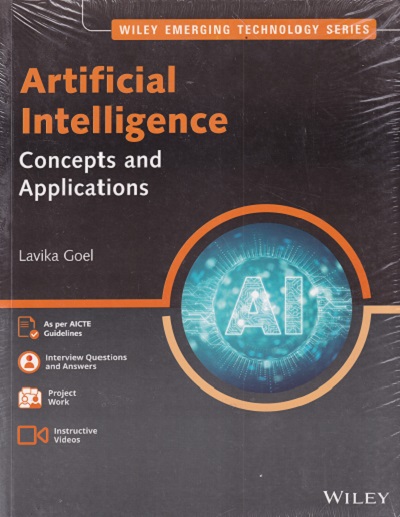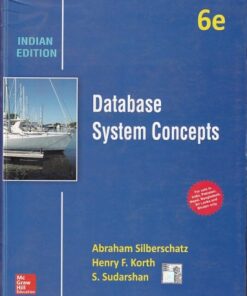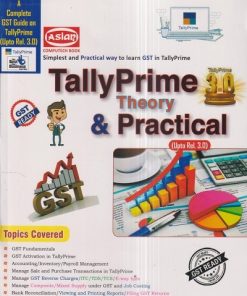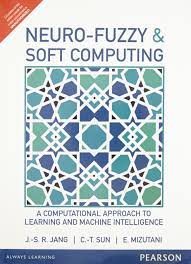About the Author
Dr. Lavika Goel is currently an Assistant Professor in the Department of Computer Science and Engineering at the Malaviya National Institute of Technology (NIT), Jaipur, Rajasthan, India. She earlier worked at the Birla Institute of Technology and Science (BITS), Pilani, for about five years. She also holds a corporate experience working at Oracle India Private Ltd. She received the prestigious Young Scientist Award by VIFRA International Foundation on 19 December, 2015 during the Annual Research Meet held in Chennai.
Contents
Chapter 1 Basics of Artificial Intelligence 1.1 What is Artificial Intelligence? 1.2 Definition of Artificial Intelligence Through Problems 1.3 History of Artificial Intelligence 1.4 Artificial Intelligence – Problems and Techniques 1.5 Production Systems 1.6 Shift in Focus of AI Towards Providing Smarter Solutions
Chapter 2 Problem Solving Methods in Artificial Intelligence 2.1 Introduction 2.2 State Space Search 2.3 Production System 2.4 Problem Characteristics 2.5 Control Strategy 2.6 Issues in the Design of Search Programs 2.7 Search Strategies 2.8 Advanced Problems
Chapter 3 Informed and Uninformed Search Strategies 3.1 Introduction 3.2 Generate-and-Test Method 3.3 Hill Climbing Method 3.4 Best First Search and A* Search 3.5 Means End Analysis 3.6 Intelligent Agents and Environment 3.7 Problem Reduction, AO* Algorithm 3.8 Constraint Satisfaction with Inference, Backtracking, and Local Search 3.9 Local Search Algorithms and Optimization Problems 3.10 Local Search in Continuous Spaces
Chapter 4 Knowledge Representation 4.1 Introduction 4.2 Ontologies, Objects, and Events 4.3 Representations and Mappings 4.4 Approaches to Knowledge Representation 4.5 Forward versus Backward Chaining 4.6 Matching and Control Knowledge 4.7 Slot and Filler Structures 4.8 Issues in Knowledge Representation 4.9 Developments in the Field of Knowledge Representation PART II Basics of Machine Learning
Chapter 5 Neural Networks and Applications 5.1 Introduction 5.2 Learning in Neural Networks 5.3 Choosing Cost Function 5.4 Types of Learning 5.5 Recurrent Neural Network 5.6 Back-propagation 5.7 Convolutional Neural Networks and Deep Neural Networks 5.8 Applications of Neural Networks 5.9 Challenges in Neural Networks
Chapter 6 Fuzzy Logic and Applications 6.1 Introduction 6.2 Set Theory 6.3 Fuzzy Set Theory 6.4 Terminology Associated with Fuzzy Sets 6.5 Fuzzification and Defuzzification 6.6 Formation of Fuzzy Rules 6.7 Fuzzy Logic Inference System 6.8 Fuzzy Database and Queries 6.9 Fuzzy Logic Control System 6.10 Fuzzy Inference Processing: Mamdani and Sugeno 6.11 Adaptive Neuro-Fuzzy Inference System 6.12 Applications
Chapter 7 Statistical Machine Learning 7.1 Introduction 7.2 Probability Axioms 7.3 Bayes’ Rule 7.4 Bayesian Network 7.5 Dynamic Bayesian Networks 7.6 Hidden Markov Model 7.7 Probabilistic Reasoning 7.8 Certainty Factor Theory 7.9 Dempster–Shafer Theory
Chapter 8 Decision Processes and Reinforcement Learning 8.1 What is Learning? 8.2 Forms of Learning 8.3 Learning Decision Trees 8.4 Theory of Learning 8.5 Learning by Examples 8.6 Inductive Learning 8.7 Explanation-Based Learning 8.8 Regression and Classification with Linear Models 8.9 Artificial Neural Networks 8.10 Parametric Models 8.11 Non-Parametric Models 8.12 Support Vector Machines 8.13 Ensemble Learning 8.14 Statistical Learning 8.15 Reinforcement Learning 8.16 Applications of Reinforcement Learning
Chapter 9 Classification Problems in Machine Learning 9.1 Utility Theory 9.2 Multi-Attribute Utility Function 9.3 Decision Network 9.4 Value of Information 9.5 Decision-Theoretic Expert Systems 9.6 Sequential Decision Problems 9.7 Multiple Agent Solution: Game Theory 9.8 Mechanism Design 9.9 Modern Approaches to Classification PART III Applications of Artificial Intelligence
Chapter 10 Game Playing 10.1 Introduction 10.2 Minimax Search Procedure 10.3 Alpha–Beta Cutoff 10.4 Imperfect Real-Time Decisions 10.5 Stochastic Games 10.6 State-of-the-Art Game Programs 10.7 Modern Examples
Chapter 11 Text Analysis and Mining 11.1 Introduction 11.2 Language Models 11.3 Text Classification 11.4 Information Retrieval 11.5 Information Extraction 11.6 Phrase Structure Grammar 11.7 Syntactic Processing 11.8 Augmented Grammars and Semantic Analysis 11.9 Discourse and Pragmatic Processing 11.10 Statistical Natural Language Processing 11.11 Cross-Lingual Natural Language Processing 11.12 Spell Checking 11.13 Speech Recognition 11.14 Use of Python’s NLTK Library in Modern Text Mining Applications 11.15 Case Study: Sentiment Analysis of User Comments on Social Networking Website Twitter using Machine Learning
Chapter 12 Expert Systems and Applications 12.1 Expert System 12.2 Knowledge Representation 12.3 Expert System Shells 12.4 Knowledge Acquisition of an Expert System 12.5 Applications of Expert Systems 12.6 Examples of Expert Systems 12.7 Problem Solving Examples
Chapter 13 First-Order Logic 13.1 Introduction 13.2 Propositional Logic 13.3 First-Order Logic
Chapter 14 Prolog 14.1 Introduction 14.2 Logic Programming: Symbolic Logic, Clausal Form 14.3 Converting English to Prolog Facts and Rules 14.4 Prolog Terminology 14.5 Variables and Arithmetic Operators 14.6 Inference Process of Prolog 14.7 Tracing Model of Execution 14.8 List Structures 14.9 Operations on List 14.10 Drawbacks of Prolog 14.11 Applications of Logic Programming
Chapter 15 Modern Artificial Intelligence Languages and Tools 15.1 Python 15.2 MATLAB 15.3 R PART V Trends in Machine Learning
Chapter 16 Concepts in Machine Learning 16.1 Introduction 16.2 Approaches to Machine Learning 16.3 Building Efficient Machine Learning Systems 16.4 Reasons for Sudden Spurt in Use of Machine Learning 16.5 Artificial Intelligence versus Machine Learning 16.6 Taxonomy of Machine Learning Based Techniques 16.7 List of Machine Learning Softwares
Chapter 17 Advanced Topics in Machine Learning 17.1 Introduction 17.2 Artificial Immune System 17.3 Swarm Intelligence 17.4 Geoscience-Based Techniques 17.5 Selection of Suitable Technique Based on Problem Characteristics 17.6 Performance Validation of Intelligent Systems Using Statistics 17.7 Applied Machine Learning
Appendix A Project Work, Appendix B Multiple-Choice Questions and Answers, Appendix C Interview Questions and Answers, Appendix D Bibliography





 Zoom
Zoom












Reviews
There are no reviews yet.